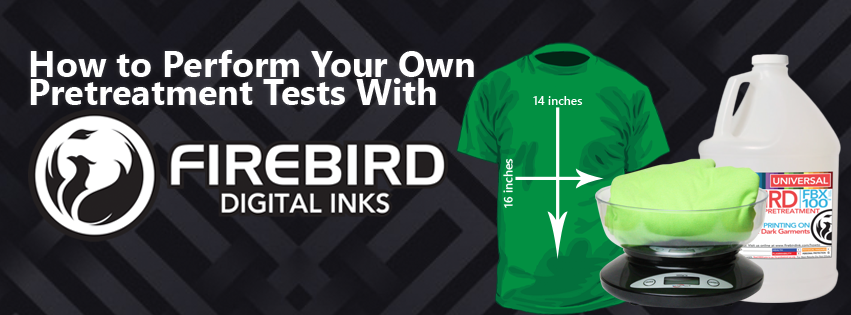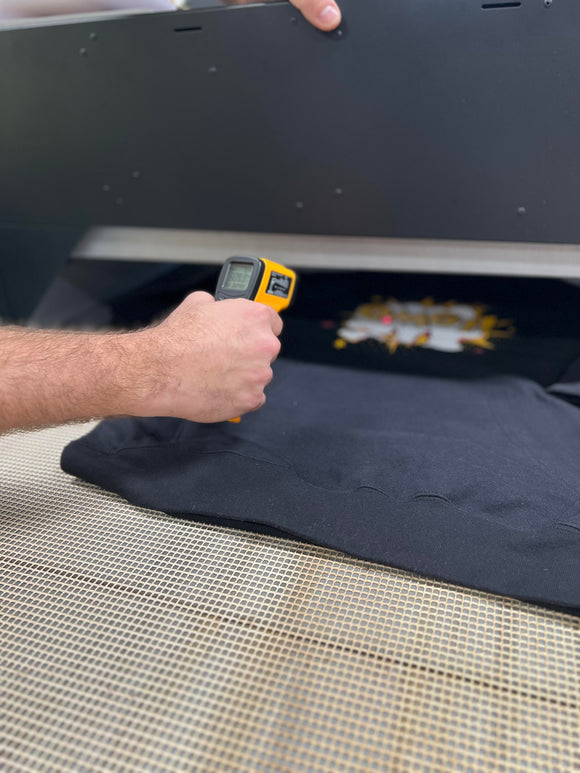
How to Perform Your Own Pretreatment Tests
Ruby Dann
Pretreatment is the most important step in DTG, but can be a cause of many problems. Most stains, poor quality prints, and wash issues can be attributed to difficulties with pretreating. However, too few shops are doing their own testing. Even when you are given settings to follow, you should perform tests to match your process with your shop’s unique environment.
What You Need
One of the most important steps is to weigh your shirts during testing. Because of this, you should have a gram scale available. FIREBIRD offers our preferred version, but any kitchen gram scale should suffice.

You should also have several shirts that you intend to print on available and a method of recording your results. The classic graph notebook works for this, but is more likely to be lost than a digital copy and can’t be copied as easily.
Finally, you will need to know the size of the area that you’re spraying onto. Ideally, you can use a consistent automatic sprayer for this. If your sprayer is inconsistent, or if you spray by hand, be sure to have a tape measure available.
Testing Your Pretreatment
1. Weigh your shirt prior to applying pretreatment.
You should be doing this for every shirt that you test, even if it is the same brand, style, and color as one that you just weighed. Ten grams of pretreatment makes a huge difference in print quality, but ten grams of fabric is unnoticeable. Make sure that you record this number.
2. Spray your shirt with pretreat.
If you have recommended settings for your sprayer, try using these as a starting out point. This is also where you should measure the size of your spray area. FIREBIRD recommends a spray area of 14×16 for consistency with heat presses and other print tests.
3. Weigh your wet shirt.
Fold your shirt so that the wet pretreatment only touches itself and place it on the scale.
4. Subtract the weight of the shirt from the new total.
This will tell you how much pretreatment you have applied.
5. Dry the shirt as usual.
This step is part of what makes your shop unique. Pretreat always needs to be fully dried before printing, but presses and dryers can be inconsistent with each other. If you notice poor continuity, it can be helpful to test the temperature of your press or the surface temperature of shirts in a dryer.

6. Record the results.
It’s important that you note your results now. Look for stains, crystals, and discoloring. Any of these might indicate issues with your shirt or process.
7. Print your shirt.
Pay attention to the quality of your print and record your results. Try to use an image that clearly shows the quality of all five DTG ink colors. FIREBIRD will often use a simple color gradient for this.
8. Wash your shirt.
This step is mostly subjective. For example, you might tell your customer to wash Direct to Garment printed shirts inside out and with cold water only. However, that customer is unlikely to follow these steps. Deciding how harsh of a test to perform is totally up to you, although we at FIREBIRD prefer the roughest settings possible.
Applying Your Results
Now that you’ve figured out what settings you need for a fully printed shirt, you can also do the math on other prints. By finding the grams applied per square inch, you also know how many grams you need on other sized images. For example, if you need 30 grams across a 14×16 area, you’re using 0.13 grams per square inch (30 grams ÷ 224 square inches). This means that you can safely spray 4-5 grams on a 6×6 left chest (0.13 g/square inch x 36 square inches = 4.68 grams).
Some shirts are inevitably going to stain or wash poorly. If you have seen this happen during your tests, you may not be able to use this shirt with DTG. This is exceptionally likely with polyester and blended shirts. Fully polyester colored fabrics cannot be reliably printed with DTG at this time and should be avoided.
If you are having trouble printing onto a shirt that FIREBIRD recommends, these tests will tell us exactly where your issue is happening. You can always call us at 203-306-2988 or email ink@firebirdink.com with any questions, comments, or concerns.


